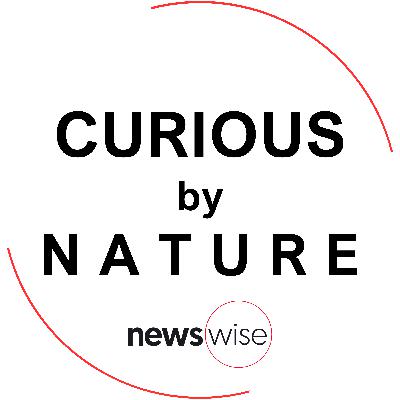Discover Curious by Nature
Curious by Nature

Curious by Nature
Author: Newswise Inc.
Subscribed: 3Played: 6Subscribe
Share
© Newswise Inc.
Description
Welcome to Curious by Nature, presented by Newswise—the podcast for curious people.
In each episode, listeners can travel briefly into the fascinating world that comes with years of dedication to one field of study. Be inspired by the many amazing things that are going on right now, some may have a major effect on our lives.
Enjoy this concentrated knowledge from experts. We hope you can take inspiration from glimpses of innovation, dedication, and discovery.
In each episode, listeners can travel briefly into the fascinating world that comes with years of dedication to one field of study. Be inspired by the many amazing things that are going on right now, some may have a major effect on our lives.
Enjoy this concentrated knowledge from experts. We hope you can take inspiration from glimpses of innovation, dedication, and discovery.
69 Episodes
Reverse
Dr. Robert Ferl, a molecular biologist and professor at the University of Florida, discusses his work on understanding how organisms, particularly plants, adapt to extreme environments, including space. He highlights his recent spaceflight aboard Blue Origin’s New Shepard, where he conducted experiments to study the effects of space travel on plants. The goal was to analyze how plants respond during the initial moments of spaceflight and upon reentry.
This unique opportunity allowed Dr. Ferl to gain first-hand experience of space, deepening his understanding of how biology behaves in space.
He talked about the importance of allowing scientists to personally conduct research in space and advocates for expanding these opportunities for others in the scientific community.
Today, we’re looking at how recent advancements in artificial intelligence are affecting education. Leaders in education will find that there are many ways to improve it.However, it may take some time before it begins to improve teachers’ lives. '
My guest today has been working in education and researching what works well. She is investigating important ways to improve student success and examining how AI is affecting teachers.
Joint replacement technology has advanced significantly in recent years, with better materials and more precise surgical techniques leading to the number of these procedures more than doubling in the past decade. But there are limitations to what patients can do after a knee or hip replacement. Many of them struggle to regain the full range of motion and stability of their younger joints, requiring extensive follow-ups and physical therapy. This week’s guest, from Mercy Medical Center in Baltimore, is using innovations like robotic surgery and implanted sensors to give patients their best chance at success with their joint replacement.
When British explorers first discovered Easter Island, and the Rapa Nui people, they were amazed at the iconic stone heads dotted around the island. But they were perplexed that this remote island, 1,000 miles off the coast of Chile in the Pacific Ocean, only had a population of a few thousand inhabitants. How could such a small nation have created these massive statues and survived in this rugged environment? From their European perspective, they made a lot of assumptions, and the prevailing theory soon became that the Rapa Nui must have been a much larger civilization that had since dwindled due to poor management of the island’s resources. A narrative took hold of the so-called “Easter Island Collapse.” But today, archeologists are working to debunk this misguided theory. We recently hosted a virtual press briefing with members of the media to discuss the latest research about Easter Island and why the evidence suggests a much more nuanced understanding of the history of its people. Newswise COO Thom Canalichio will introduce our guest and moderate the briefing.
Addiction research has been looking at chemical dependence on drugs and alcohol for many years, but new phenomena such as video games and social media have not yet been researched to the same extent. Parents are rightly concerned that their children might be exhibiting addictive behavior when it comes to these modern technologies. While game developers and social media companies are doing everything they can to increase engagement and the time users spend on their sites, what safeguards are in place to protect us from being manipulated to the point of addiction? Dr. Manchanda is trying to find answers and make sense of these potentially addictive technologies.
Estimates suggest that 10 - 30% of students are neurodivergent. What does the future employment of these students look like? Neurodiverse employees have many strengths, but can companies adjust to the needs of these employees? Dr. Eric Patton has a new book, Neurodiversity and Work, which looks at many aspects that can be improved for employees and companies.
When most people hear about youth suicide and depression, they have an immediate and normal negative response. However, today I ask you to listen to this so you can hear some of the ways you can catch the first signs of depression or other mental health issues in young people around you. The signs can be visible 10-12 years before a problem becomes apparent. And noticing and acting early can be so helpful and crucial. Dr. Trivedi has dedicated his career to finding solutions to serious mental health problems.
Researchers who study Alzheimer’s are looking at the way the disease changes the brain from every possible angle. You’ve probably heard about amyloid plaques and neural tangles, but there is another field of study that looks closely at the way brain cells metabolize small molecules such as lipids and amino acids. This study of Metabolomics reveals that patients with Alzheimer’s Disease often exhibit dysfunction of these processes in the brain. Our guest today is working to narrow down what this might mean, and how it might help to better diagnose, predict, and prevent the progression of Alzheimer’s.
In the post-Civil War South, segregated, state-run reform schools became a source of cheap farm labor through the convict-leasing act. Decades later, investigators have uncovered patterns of abuse and discrimination in the running of these schools, and perhaps more importantly, the lack of historical documentation of what went on there. Our guest today is one such investigator. From the anthropology department at Furman University in Greenville, South Carolina, she specializes in cultural and collective memory, especially where it intersects with race and criminal justice. She joins us to talk about the question, “How do we, as a society, pass down knowledge of and memorialize the past?”.
Countless blockbuster movies have depicted a world where humanity is on the brink of destruction. But in the real world, what would it take to be an existential threat? Could a terrorist attack wipe us out? What can we do to prepare for the worst and ensure our survival?
Patients with cancers of the blood, such as leukemia and lymphoma, often need to undergo a bone marrow transplant. In the past, this was a painful and complicated procedure that often didn’t work. Our guest today has dedicated her career to working on ways to make blood and bone marrow transplants more effective.
We are all getting older. But scientists that study aging have made progress understanding what happens to us later in life, and what we can do to stay healthier, longer. Everyone wants to know how to keep feeling young.
In Greenville, South Carolina, environmental scientists are figuring out more advanced ways to study the health and biodiversity of our ecosystems. One way they are doing this is by simply listening. Birdsong has proven to be an effective method to study biodiversity. One researcher at Furman University sat down to talk with us about how he is applying this concept to judge whether land management practices are effective.
When our guest today first began working as a scientist, our understanding of atomic particles was only beginning. Now, from the University of Athens and CERN, she is part of an enormous operation of thousands of people and an engineering wonder in the 27 km radius particle accelerator known as the Large Had-Run Collider. We’ll talk about where she’s been, what she has seen throughout her remarkable career, and what is keeping her curious and excited about science to this day.
What makes a boss bad or good? It’s something everyone probably has an opinion about. At the University of Iowa, there is someone that has made this his life’s work. It’s one part business school, one part applied psychology, and a lot of really great insights into human nature. His most cited paper to date discusses Transformational Leadership, a subject which we sat down to discuss.
Heart attacks are the leading cause of death worldwide, but what many people don’t know is that younger adults, especially women, they are at risk. Too often, their symptoms are dismissed, or the real cause is missed entirely.Dr. Claire Raphael, interventional cardiologist at Mayo Clinic, led a 15-year study uncovering these hidden causes: artery tears, coronary spasms, and other conditions that standard tests don’t always detect. These findings are critical because they explain why so many young women are misdiagnosed and why lives are being lost unnecessarily.Her research is forcing medicine to rethink long-held assumptions about who gets heart attacks and why. And the takeaway is simple: awareness saves lives.
The research duo of Greg Tarle and Kevin Croker have a theory about black holes that is so revolutionary that, if proven true, would reshape our understanding of the universe and its origins in the big band. They study the complex interactions between gravity and matter at the enormous scale of an imploding star, with forces so great that not even light can escape. And if you’ve ever wondered what it sounds like when two black holes collide, the answer may surprise you! As researchers use fine-tuned, sophisticated equipment to detect and study black holes merging, they peer back into the ancient history of the universe and hope to explain how the it seems to be expanding at an ever increasing rate.
Sports psychologists often examine the high-pressure, high-performance demands of professional athletes partly because sports provide a natural laboratory to study the effects of failure on the human psyche. Our guest today studies sports as a place where mistakes happen constantly, pressure never lets up, and resilience is the skill that separates those who burn out from those who thrive. By studying this environment, he hopes to use science to help people develop resilience in the face of adversity. His work bridges research and practice, studying how athletes, musicians, pilots, and other high performers can develop emotional control and bounce back stronger from setbacks.From Olympic competition to weekend matches, his research reveals how resilience is built, why it matters at every level of sport, and how its benefits extend far beyond the game into everyday life.
Wildfires are often seen as destructive, but history tells a different story. Our guest today studies the deep relationship between people, fire, and landscapes, uncovering how Indigenous fire practices shaped ecosystems for centuries. Using tree rings and archaeology, Dr. Christopher Roos reveals how the Western Apache managed fire to buffer against drought and climate extremes, lessons that could guide us today as wildfires grow more severe. His work connects the past to the present, showing how cultural knowledge and science together can help us live with fire, not just fight it.
Taylor Swift is one of the biggest musicians of our time, but why?Our guest today is the author of Cranking Up Taylor Swift: Her Musical Journey in 11 Songs, and dives deep into the music, not to simply celebrate her success, but to ask why her work resonates, how it reflects larger cultural shifts, and what it reveals about the evolving sound of country and pop in the 21st century.






